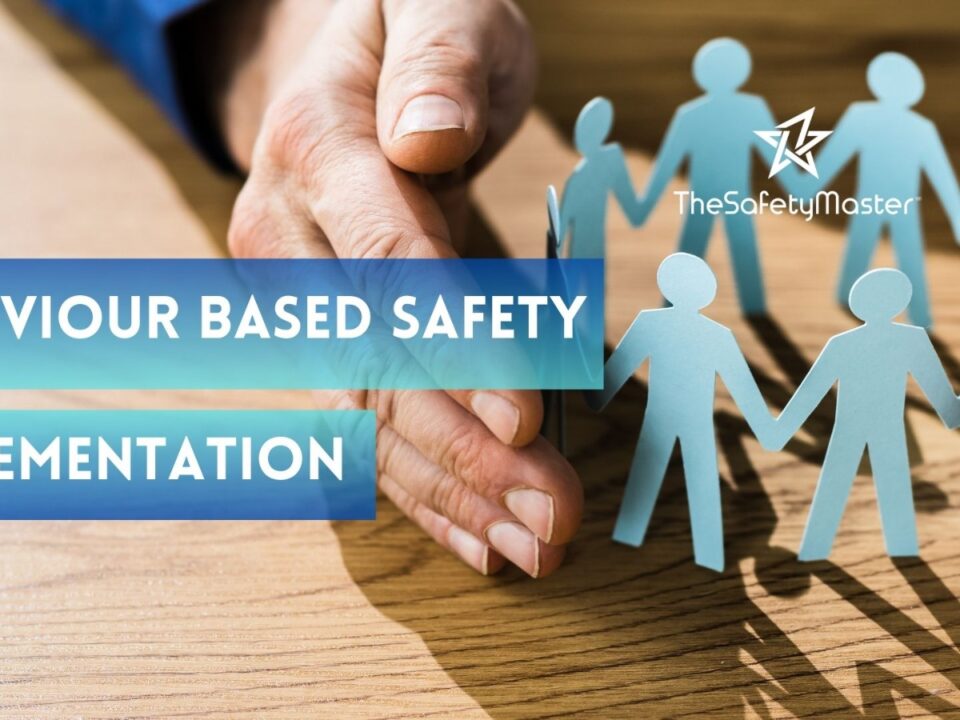How to Drive a Positive Safety Culture Transformation with Behavior-Based Safety Programs

Hazardous Waste Management Audit
May 26, 2023
Key Elements of a Successful HAZID Study in the Oil & Gas Industry
May 31, 2023How to Drive a Positive Safety Culture Transformation with Behavior-Based Safety Programs
A positive safety culture is essential for any organization that values the well-being of its employees. Unfortunately, achieving such a culture can be challenging, especially when traditional safety programs are not enough to create meaningful change. In this article, we will explore how behavior-based safety programs can help drive a positive safety culture transformation within your organization.
By following the steps outlined in this article, you will learn how to assess your current safety culture, identify areas for improvement and develop a customized behavior-based safety program that will help create a safer work environment. We’ll also provide real-life success stories and examples to inspire you on your journey towards creating a truly positive safety culture within your organization.
Understanding Behavior-Based Safety Programs
Behavior-based safety programs are a key component of a positive safety culture transformation. The premise behind these programs is that by changing employee behavior, you can reduce the number of accidents and injuries in the workplace. In a behavior-based safety program, employees are encouraged to take proactive measures to identify potential hazards and come up with solutions to eliminate or reduce those hazards.
The goal of such programs is not just to increase safety but also to create a culture where everyone is involved in ensuring that the workplace is safe for themselves and others. By creating this kind of environment, employees feel empowered, motivated, and engaged in their work while reducing accidents and injuries. It requires continuous effort from management and employees alike but can lead to significant benefits for organizations looking to create a positive safety culture.
Step 1: Define Your Safety Goals and Objectives
Before beginning a behavior-based safety program, it’s essential to define your safety goals and objectives. Establishing clear and concise goals ensures that your program stays on track and is successful in achieving its intended outcomes. While the ultimate goal of any safety program is to prevent injuries, it’s crucial to identify specific objectives that support this larger goal.
When setting your safety goals and objectives, consider the unique needs and risks associated with your organization or industry. For example, if you work in construction, your primary objective may be to reduce falls from heights. Alternatively, if you work in a manufacturing facility, reducing incidents of machine-related injuries may be a top priority. Whatever your specific goals may be, make sure they align with your organization’s overall mission statement and values.
Step 2: Assess Your Current Safety Culture
Before you can improve your safety culture, you need to understand where your organization currently stands. This step involves assessing the current state of your safety culture by evaluating the attitudes and behaviors towards safety within your organization.
An assessment of your current safety culture involves gathering data from various sources such as employee surveys, incident reports, observations, and interviews with key stakeholders. You need to identify gaps in knowledge and understanding among employees regarding safe practices and areas where they may be taking shortcuts or risks that compromise their safety. By conducting an audit of your current safety culture, you will be able to identify key areas that require improvement.
Assessing your current safety culture is an important step in the journey towards a positive safety transformation because it provides a baseline for you to measure progress against. It allows you to set achievable goals for improvement while identifying potential challenges that could hinder progress. A thorough assessment of your current state is essential if you want to develop effective strategies for transforming into a positive safety culture.
Step 3: Identify Areas for Improvement
Before developing a behavior-based safety program, it’s important to identify areas for improvement in your current safety culture. Conducting a thorough assessment can help you pinpoint specific behaviors, attitudes, and environmental factors that may be contributing to safety issues or incidents.
Some helpful tools for identifying areas for improvement include conducting employee surveys or focus groups, reviewing incident reports and near-miss data, analyzing safety policies and procedures, and observing work practices. It’s important to involve employees at all levels in the assessment process to gain a comprehensive understanding of the current safety culture.
Once you have identified areas for improvement, prioritize them based on their potential impact on safety performance and the feasibility of addressing them through a behavior-based safety program. This step lays the foundation for developing an effective program that addresses the root causes of unsafe behaviors and promotes positive change within your organization.
Step 4: Develop a Behavior-Based Safety Program
After identifying areas for improvement, it is time to develop a behavior-based safety program that aligns with your safety goals and objectives. This program should focus on changing the behaviors of employees to promote safe practices and reduce the risks of accidents.
The behavior-based safety program should include clear expectations for employees, as well as consequences for non-compliance. It should also provide opportunities for positive reinforcement of safe behaviors that are observed. In addition, the program should incorporate ongoing training and support to ensure its success.
A key component of developing an effective behavior-based safety program is involving all levels of the organization in its creation. This ensures buy-in and commitment from everyone, which can lead to greater success in implementing and sustaining the program over time. By working together, organizations can create a culture where safety is a top priority.
Step 5: Implement and Communicate the Program to Your Team
After developing a behavior-based safety program, it is important to effectively implement and communicate it to your team. This step is crucial in ensuring that the program is well-received by everyone and that they understand their roles in contributing to a positive safety culture.
Start by identifying key stakeholders within your organization who will be responsible for leading the implementation process. These individuals should be trained on the details of the program and how it aligns with your safety goals and objectives. Once they are knowledgeable about the program, they can communicate its importance to other team members, answer questions, and address concerns.
Next, use a variety of communication channels such as emails, newsletters, bulletin boards, meetings, and training sessions to spread awareness about the behavior-based safety program throughout your organization. It is important that everyone understands why this initiative is being implemented and how it will benefit them personally. By communicating effectively with your team members from all levels of your organization regularly – you can keep them engaged in the process – motivated enough that they will become enthusiastic contributors.
Step 6: Provide Ongoing Training and Support
Providing ongoing training and support is essential to the success of any behavior-based safety program. Employees need to receive consistent and relevant training to reinforce safe behaviors and understand the importance of their role in maintaining a positive safety culture.
Ongoing training should include regular safety meetings, toolbox talks, workshops, and other interactive activities that engage employees in the process. It is also important to provide individual coaching sessions for employees who may need extra support or guidance.
Support can come in the form of recognition programs, incentives, and feedback mechanisms that recognize employees for their positive contributions to the safety culture. By providing ongoing training and support, you can reinforce safe behaviors, improve employee engagement and retention rates, and drive a positive safety culture transformation that will benefit everyone in your organization.
Step 7: Monitor Progress and Evaluate the Program
The final step in driving a positive safety culture transformation with behavior-based safety (BBS) programs is to monitor progress and evaluate the program. This step involves tracking the results of your BBS program to determine whether it is working as intended, identifying areas for improvement, and making appropriate changes to the program.
One way to monitor progress is to use leading and lagging indicators. Leading indicators are proactive measures that predict future performance, while lagging indicators measure past performance. Some leading indicators you can track include participation rates in safety activities, hazard identification rates, and near-miss reporting rates. Lagging indicators can include injury rates, lost time due to injuries, and workers’ compensation costs.
Evaluation can be done through feedback mechanisms such as surveys or focus groups involving employees at various levels within your organization. The results of these evaluations can provide valuable insights into how well your BBS program is working and where improvements may be needed. It’s important that all feedback received should be thoroughly evaluated before making any changes.
In conclusion, monitoring progress and evaluating BBS programs should be an ongoing process so that any necessary adjustments can be made quickly. By staying vigilant about tracking progress and continuously improving your safety culture through effective BBS programs you will notice increased employee engagement on matters related to health & safety which will ultimately lead to a safer workplace environment for everyone.
The Benefits of a Positive Safety Culture Transformation
A positive safety culture transformation is essential for any workplace that values the well-being of its employees. When implemented correctly, behavior-based safety programs can lead to a reduction in accidents and injuries, higher employee morale, and increased productivity.
One of the main benefits of a positive safety culture transformation is a reduction in accidents and injuries. By implementing behavior-based safety programs, you can identify potential hazards before they cause harm. This proactive approach helps prevent accidents from occurring and reduces the number of injuries sustained by employees.
Another benefit is higher employee morale. When employees feel safe at work, they are more productive and engaged. A positive safety culture also fosters a sense of teamwork and trust among colleagues as everyone works together towards a common goal – ensuring each other’s safety.
In addition to reducing accidents and increasing employee morale, there are financial benefits to a positive safety culture transformation as well. Implementing behavior-based safety programs can reduce workers’ compensation claims, insurance premiums, and other costs associated with workplace injuries.
In conclusion, driving a positive safety culture transformation with behavior-based safety programs has numerous benefits for both employers and employees alike. By prioritizing the well-being of your workforce through proactive measures like these programs, you can create an environment where everyone feels safe, valued, and motivated to do their best work.
Real-Life Success Stories and Examples
Behavior-based safety programs have been implemented in numerous industries with great success. One such example is ExxonMobil’s “Safety Culture Journey” program. This program was launched in 2005, and by 2014, ExxonMobil had reduced its total recordable incident rate by 52%. The company attributes much of this success to the behavior-based safety program they implemented, which involved employees at every level of the organization.
Another example is Alcoa’s behavior-based safety program, which was launched in the late 1980s. Through the implementation of this program, Alcoa saw a significant reduction in workplace injuries and illnesses across all of its locations. In fact, between 1988 and 1997, Alcoa’s lost workday rate decreased by over 90%. This success was due in large part to Alcoa’s commitment to building a positive safety culture through their behavior-based safety program.
At TSM TheSafetyMaster Private Limited, we offer following services
- Behavior Based Safety Training
- Behavior Based Safety Implementation
- Safety Culture Transformation
- Safety perception Survey
- BBS Software
- HAZOP Study
- Quantitative Risk Assessment
- Safety Integrity level Assessment
- HAZOP Training
TSM TheSafetyMaster® Private Limited
Unit No 221-451-452, SPL1/J, 2nd & 4th Floor, Sunsquare Plaza Complex, RIICO Chowk, Bhiwadi 301019, Rajasthan, India
Phone: +91 1493 22 0093
Mobile: +91 7665231743/9413882016
Email: info@thesafetymaster.com




